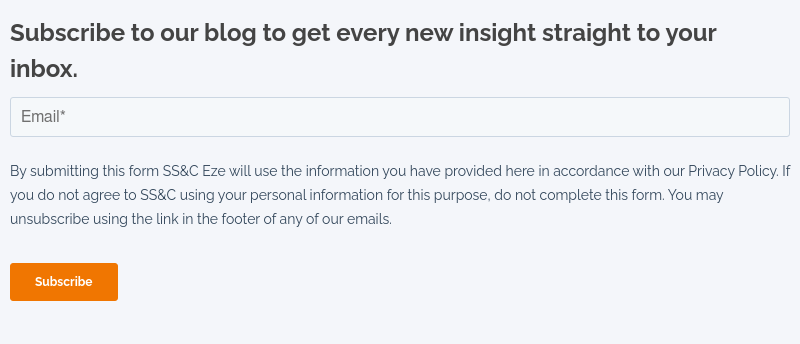In the TabbFORUM Annual Trends Report, Colby Jenkins, TabbFORUM contributing writer and an expert in electronic trading and market structure, explores the latest developments shaping the Order Management System (OMS) and Execution Management System (EMS) landscape, specifically looking at combined OEMS solutions.
As Colby points out, trends that have long defined the OEMS space are now accelerating. Demand for access to new markets, asset classes, and enhanced workflow connectivity is surging across a complex and evolving market structure.
These rapid changes are placing greater pressure on OMS and EMS systems to adapt to both operational and technological challenges.
To gain deeper insights into how technology is evolving to meet these demands, Colby interviewed a range of OEMS users and industry leaders, including Andrew Rosenthal, a senior director of business development at SS&C.

Choosing the Right Front-office Technology Model: Modularity vs. End-to-End
Colby’s research reveals that as market complexity increases, the expectations placed on OMS and EMS vendors have grown significantly. Vendors must now stay competitive by delivering seamless efficiency across the interconnected domains of investing, trading, risk management, and compliance.
According to Colby’s report, selecting the right OMS/EMS solution depends largely on a firm’s unique needs. He notes that two primary approaches dominate the market:
- End-to-End Front Offices: These systems provide simplicity by offering a unified OEMS platform where all workflows are closely integrated.
- Modular Front Offices: A best-in-class approach that allows firms to customize their technology stack by selecting individual front-office components tailored to their specific needs.
Each approach offers its own set of potential opportunities and challenges, making it difficult to choose the right solution. As one decision-maker interviewed by Colby notes, “A lot of the time you simply do not know what you don’t know. With cutting-edge technology, this can lead to analysis paralysis.”
For firms opting for an end-to-end front-office solution, SS&C’s Andrew Rosenthal stresses the importance of seamless integration to create a unified workflow. He explains:
"Look for a front-office tech stack that is truly unified and fully synchronized. This ensures that users no longer have to swivel between systems—any activity occurring in the EMS is simultaneously reflected in the OMS in real-time, and vice versa."
The Eze OEMS exemplifies how seamless integration can streamline workflows while delivering a tailored user experience. Regardless of asset class, the platform allows users to customize dashboards to fit their roles while maintaining visibility and collaboration across the firm.
As Colby’s TabbFORUM report highlights, selecting the right OMS/EMS solution isn’t just about technology—it’s about empowering firms to navigate the complexities of modern markets with confidence and efficiency.
Evolving Market Dynamics Reshape the Trading Ecosystem
Workflows, buy-side client types, and asset classes have seen significant advancements in recent years, giving rise to what Tabb refers to as a “wholly new trading ecosystem.”
As one fixed-income trader from a US-based asset management firm noted, “It’s just about night and day how we are approaching markets today compared to even just a decade ago.”
Andrew echoes this sentiment, emphasizing the rapid pace of change: “Requirements are evolving faster than ever. As a result, the software firms rely on to manage their business must be flexible enough to keep up with these demands.”
To meet this need for adaptability, technologies like the Eze OEMS are designed to support all asset classes and strategies within a single platform—eliminating the need for auxiliary systems.
“No matter how our clients adjust their strategies, explore new asset classes, or implement new compliance rules, they have a tech stack that empowers them to do so with confidence,” adds Andrew.
Supporting Firms as They Do More with Less
The challenges highlighted in the TabbFORUM research—ranging from demands for new markets, asset classes, and workflows to a broader client base—are driving investment firms to place a greater emphasis on efficiency.
As the TabbFORUM Report notes, the time required to complete both major and minor tasks is becoming an increasingly critical factor in technological decision-making.
In response to these pressures, Andrew advises firms to consider the interconnectivity and data consistency provided by an investment ecosystem. Unified solutions like these are proving to be invaluable assets for firms aiming to do more with fewer resources.
By creating a single source of truth, these ecosystems enhance communication between traders, portfolio managers, and other team members, streamlining operational processes and paving the way for greater collaboration and innovation.
Powerful and Adaptable: The SS&C Front Office
A strong technical foundation enables SS&C to offer users modern front-office technology that keeps pace with changing market trends, investor preferences, and shifts in operations today—and well into the future.
Our technology—from the backend architecture to front-office features—is developed and serviced by hundreds of experts with knowledge of the industry, investment firm operations, and front-office needs. This combination of people, technology, and commitment to client success gives firms the resources they need to navigate changing markets.
Access more information about the Eze OEMS. Or read the TabbFORUM research.

